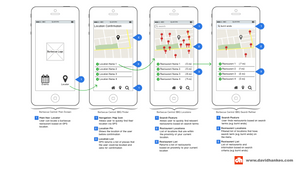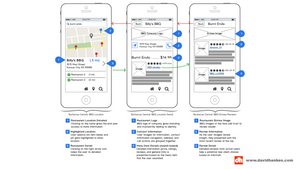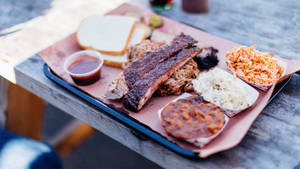
Barbecue Central — a Conceptual Mobile App
Objective
Barbecue can be defined as an outdoor activity of friends, family, and burgers or a culinary way of preparing meats, vegetables, and desserts on an open flame. Information about barbecuing is scattered throughout the Internet on personal and professional websites with no specific website to encompass all things barbecue. Barbecue Central’s mobile experience allows a barbecue connoisseur the ability to simply find restaurants based on their current location, search based on typical menu entrees, and make a connection based on other Barbecue Central reviews.
Target Audience
- I love barbecue and need a tailored experience based on my palate.
- I need to find barbecue places with a simple click.
- I want to find an experience without reading through average search results.
- I desire a great barbecue experience based on menu selections and reviews.
Persona
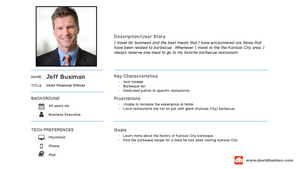
Scenario
Jeff, a business executive, travels to Kansas City, KS for a business conference once per year. He loves the barbecue he gets in his hometown, but acknowledges barbecue in Kansas City is much better. He opens the Barbecue Central app on his mobile phone and immediately clicks the map feature to locate his current position. The app asks him to confirm his hotel’s name and address which he completes. He clicks on the magnifying glass to start his search for “burnt ends.” As he types, the search box finishes the search term and automatically starts searching for restaurants. The app returns search results, with reviews and some filter. Feeling confident with those results, Jeff clicks the barbecue restaurant with the best reviews and closest to his hotel. He is able to see the location on a map and choose, if needed, to get directions or call them direct. Since the application remembers his search criteria it presents him with that item from the menu with pictures and detailed information.
Use Case
- I am from out of town and want to find a great barbecue restaurant close to my hotel
- I do not prefer franchised restaurant, but rather “off the beaten path” originals
- I love all types of barbecue, but my all time favorite item is burnt ends
- I know barbecue can be expensive, but great reviews by other barbecue connoisseurs help steer my decision
Mobile Context
“I am always traveling for work, but when I am away from home I love to try new barbecue restaurants. I need to be able to find something quickly and most of all the best place in town based on ratings.”
Since a majority of Barbecue Central’s website dealt with visitor’s foraging and snacking for history, recipes, and food selection; the mobile context uses the wealth of barbecue knowledge from the website and helps mobile users find information on restaurants, events, etc. The mobile user is primarily very busy and extremely mobile. They rely on the mobile application to find barbecue locations which are found on the Barbecue Central website, but their experience on the app is focused towards specific tasks: locate me, find a restaurant based on my location, refine restaurants based on my barbecue needs, and read entree details and reviews to make the ideal barbecue experience decision no matter where I travel.
Sketches
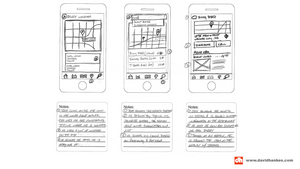
Wireframes
